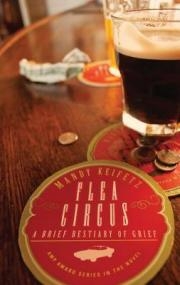
Flea Circus: A Brief Bestiary of Grief
by Mandy Keifetz
New Issues Poetry & Prose/Western Michigan University
Mandy Keifetz’s AWP Award–winning novel, Flea Circus: A Brief Bestiary of Grief, opens with a long, lyrical lament from Izzy, the narrator, addressed to her lover, Timmy (merchant marine turned entomologist turned performance artist-flea circus breeder, proprietor, and master of ceremonies), who has recently killed himself by leaping from their New York tenement apartment window. Phew! Yes, a long sentence to open with, but necessary to provide a sense of this sad, comic, and somewhat absurdist story before delving into its complex parts.
The novel contains twenty-six chapters, forming an abecedary. The first sentence in chapter 1 is simply “A is for Altamont,” the couple’s cat, who is named for the tragic Altamont Speedway Free Festival, which occurred in 1969, before the narrator was born. Altamont the cat is “brown and fat like a coconut, and riddled with fleas.” As Izzy reminds Timmy in her second-person narration, “Not cat fleas. Hedgehog fleas. Archaeopsylla, erinacei you used to call them.” Keifetz’s language becomes an amazing performance of somersaulting sentences when she has Izzy recall how she and Timmy first spotted one another: “I used to sit on my fire escape in the late afternoons, watching you watching the kids play in the mud and alley cat shit at the base of the airshaft. Watching you watching me watching the kids. Watching the kids watching us flirt by watching them.”
But it is Altamont, whom they kidnap (catnap?) from the putrid apartment of the mean and crazy cat-lady in their building, who ultimately brings them together. The cat’s name, and the attention he receives from Keifetz, suggests significance. Yet for at least the first quarter of the novel the significance is mysterious. More about that later.
Along with the alphabetical chapter titles, the language within the chapters plays with words beginning with the spotlighted letter. This form could seem gimmicky (similar things have been done), yet Keifetz’s artful alliteration and sorrowful lyricism manage to make her usage feel authentic, the desultory musings that might issue from a grief-stricken woman trying to figure out why her seemingly happy lover offed himself. Take for example (from chapter 6, “Flea Circus”), her ruminations on words that start with the letter F: “Flew. Flung. Flap. Flail. Flee. Flea. I note here, I must note here, without malice or irony, or even I hope, emotion, the preponderance of fl- words that can describe your blond-boy flight.”
This chapter, which also provides a brief history of flea circuses in general and Timmy’s in particular, is my favorite. I’ve heard about flea circuses for most of my life and wondered (though not enough to investigate) whether they were real. During Tim’s life, when asked by friends about his circus’s authenticity, Izzy answers: “Yes, he trains them. Yes, they’re alive. Yes, he glues them in place. Yes, it’s showmanship. Yes.”
Her response forced me to research its veracity, and I found that much of what she says is probably true. No, fleas cannot be trained, but reportedly a hair-thin harness can be looped around a flea’s neck and connected to a cart many times the flea’s size so that it appears the insect is pulling a comparatively gigantic load. Fleas are extremely strong (as Izzy tells us in chapter 8, a flea can leap “150 times its length laterally”).
“To dress up his fleas,” Izzy claims, “Tim used a technique developed by an order of Mexican nuns whose pulgas vestidas, tricked out as peasants, ladies of the evening, bar keeps . . . and [were then] mounted under shards of magnifying glass.” Tim’s grand flea finale was even more dramatic and not fatal to the fleas—a small handmade Trojan horse filled, one by one, with a thousand fleas. As Izzy tells it, when the mass of fleas were let loose from the horse’s belly, “jaws fell” and “gasps of wonderment escaped the crowd.”
But the story is much larger than that of the flea circus. We learn of the dreamlike relationship between Izzy (who resembles the picture hanging over their bed of the childlike St. Evlalia [sic], with hair “the impossible color of a fine single malt”) and Timmy (whose flashing green eyes seem “to register every nuance, every shudder, every change in pressure and temperature”). Phew (again)! They seemed devoted to each other and had a sex life “so good, it was excruciating.” We learn of Izzy’s job as an immolator (in this context, a Kafkaesque bank job that consists of writing letters intended to kill the letter writer’s request in a morass of officialdom). We learn of the job Izzy temporarily takes at Timmy’s brother’s Red Hook Bar when she is too unglued to return to her cubicle at the bank. We meet a wide cast of idiosyncratic characters, from the residents in the tenement to the customers (“C is for customer”) in the bar, including young hipsters and old drunks. Of these, Izzy connects most with Coogan, a shipworker turned forensic anthropologist whose “nose is an awful red potato, and on his temple, the snake is out . . . an angry blue vein that pulses from his eyebrow to his ear.” His face is “framed by thin white hair, yellow ’cause he never washed it . . . [which] turned white with age then yellow again with dirt.” We live through Izzy’s pregnancy scare and relive part of her childhood in New Jersey, where as a teenager she loved her job at the Haunted Mansion. We come to see, believe in, and miss Timmy, and wonder at the fact that he could end such an extraordinary existence.
Around mid-novel, when the narration shifts from being predominantly second person to first person and we learn of Izzy’s history with cars and her dreams about Timmy in a car, we begin to understand the foreshadowing encapsulated in Altamont the cat’s being named after the ill-fated speedway. This shift is also where the novel’s absurdity begins to stretch the limits of the contract established early on and Keifetz appears boxed into her story. In chapter 10 (“J is for Jangle”), Izzy’s soon-to-be new lover, Pudge Goroguchi, appears driving a “’71 Road Runner, show-room perfect, lime green with a black vinyl top” and “a shark’s face decal” on the “pop-up air grabber” to deliver a hand-built artificial dog Timmy ordered prior to his death. In a novel where I fell in love with a performance-art flea circus, I expect to be wowed by an artificial dog. Yet the dog never fulfills its promise and fizzles almost as soon as it appears. The novel’s weirdness begins to seem more for the sake of weird than to wring magic from a story that is alive with characters who dance on the page. Hence the urgency fades.
That said, the novel continues to be engaging as Izzy involves us in her ruminations about life, shares facts about physics and velocity, and plays math games with us. At this halfway point I began to dread what I suspected (correctly) was the conclusion, but we all know that the journey is what matters most. Much of this journey is both dazzling and devastating—as Izzy herself tells us, “if we ourselves are human, we are moved by the beautiful pointlessness of it all.”


